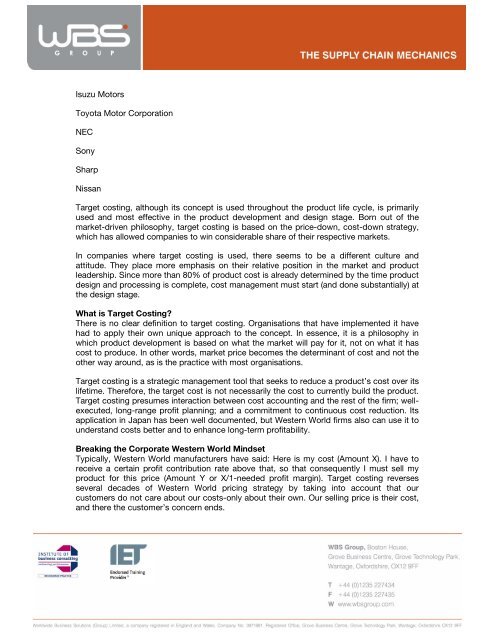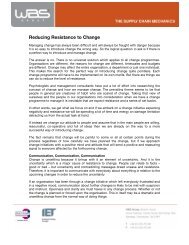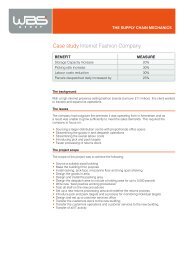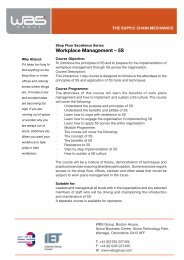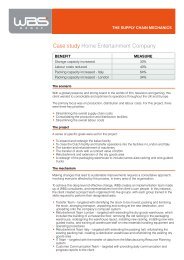TARGET COSTING - WBS Group
TARGET COSTING - WBS Group
TARGET COSTING - WBS Group
Create successful ePaper yourself
Turn your PDF publications into a flip-book with our unique Google optimized e-Paper software.
Isuzu Motors<br />
Toyota Motor Corporation<br />
NEC<br />
Sony<br />
Sharp<br />
Nissan<br />
Target costing, although its concept is used throughout the product life cycle, is primarily<br />
used and most effective in the product development and design stage. Born out of the<br />
market-driven philosophy, target costing is based on the price-down, cost-down strategy,<br />
which has allowed companies to win considerable share of their respective markets.<br />
In companies where target costing is used, there seems to be a different culture and<br />
attitude. They place more emphasis on their relative position in the market and product<br />
leadership. Since more than 80% of product cost is already determined by the time product<br />
design and processing is complete, cost management must start (and done substantially) at<br />
the design stage.<br />
What is Target Costing?<br />
There is no clear definition to target costing. Organisations that have implemented it have<br />
had to apply their own unique approach to the concept. In essence, it is a philosophy in<br />
which product development is based on what the market will pay for it, not on what it has<br />
cost to produce. In other words, market price becomes the determinant of cost and not the<br />
other way around, as is the practice with most organisations.<br />
Target costing is a strategic management tool that seeks to reduce a product’s cost over its<br />
lifetime. Therefore, the target cost is not necessarily the cost to currently build the product.<br />
Target costing presumes interaction between cost accounting and the rest of the firm; wellexecuted,<br />
long-range profit planning; and a commitment to continuous cost reduction. Its<br />
application in Japan has been well documented, but Western World firms also can use it to<br />
understand costs better and to enhance long-term profitability.<br />
Breaking the Corporate Western World Mindset<br />
Typically, Western World manufacturers have said: Here is my cost (Amount X). I have to<br />
receive a certain profit contribution rate above that, so that consequently I must sell my<br />
product for this price (Amount Y or X/1-needed profit margin). Target costing reverses<br />
several decades of Western World pricing strategy by taking into account that our<br />
customers do not care about our costs-only about their own. Our selling price is their cost,<br />
and there the customer’s concern ends.


